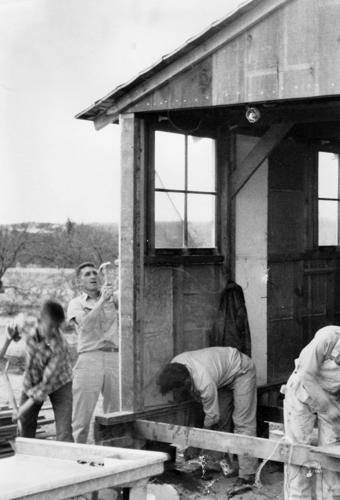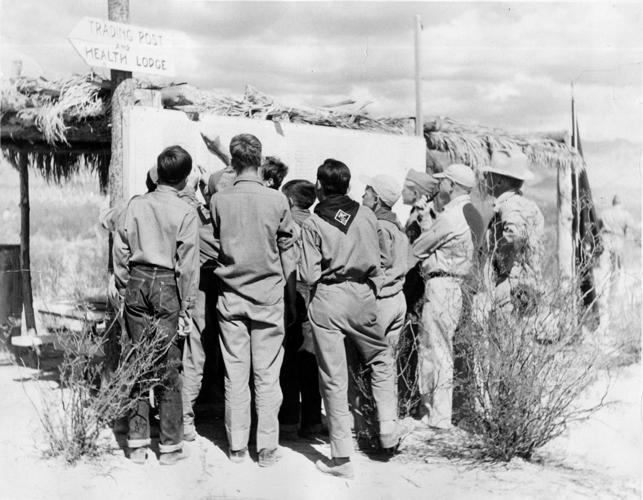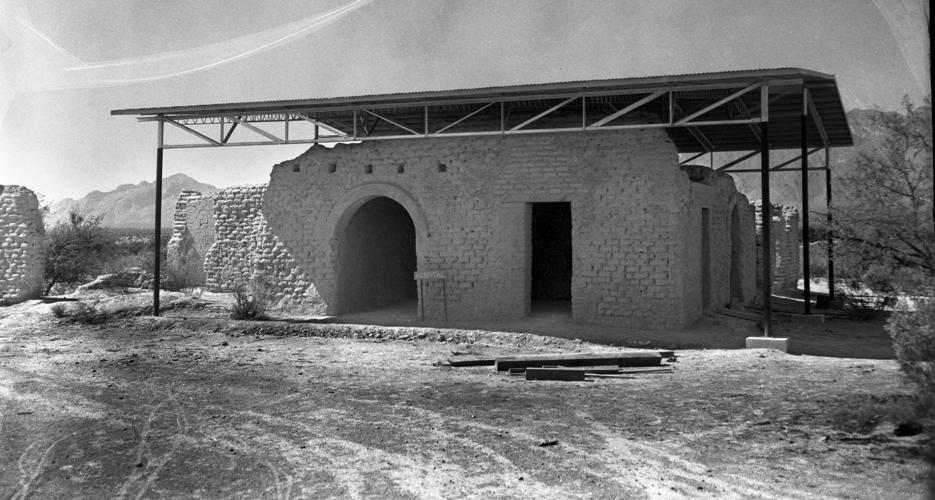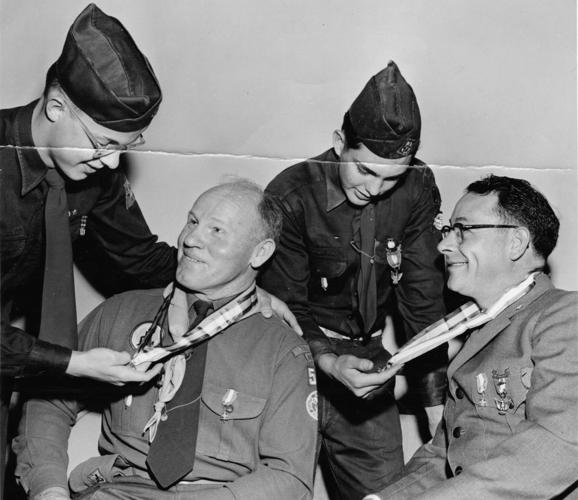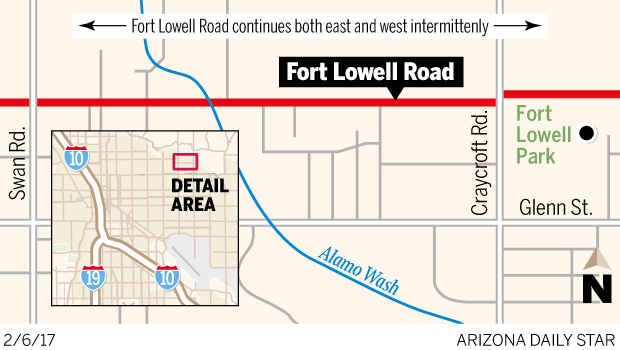If not for Fort Lowell’s longtime connection to the Boy Scouts, the abandoned, historic post might have been razed for a housing subdivision in the 1940s.
In 1873, Col. Eugene Asa Carr (namesake of Asa Carr Way) chose the fort’s site about 7 miles northeast of town. In time, an adobe hospital, quartermaster depot, officers’ quarters and barracks were built, with the parade ground in the center. In 1891, the fort was abandoned and the last American flag flown over it was lowered.
The land east of present-day Craycroft Road was under the control of the state by 1900; it’s believed farmers were living in a few of the structures.
In April 1912, the Boy Scouts of Tucson, established the year before by Harold Steele (namesake of Steele Elementary), marched out to the old fort under the command of a member of the University of Arizona’s military cadet program.
The Arizona Daily Star wrote, “Regular maneuvers will take place every day and they will be virtually soldiers in camp.” Not all of the time was spent on drilling, however. During at least one day of the week-long encampment, the boys searched for an old cannon that had been spotted several years before and scoured for Native American artifacts.
In 1914, the Boy Scouts of Tucson rifle competition was held at the old fort.
Also that year, a new scouting organization was formed of boys who lived in the neighborhood that developed around the fort’s ruins, called El Fuerte, and a little to the west, in the area populated by Mormons that would be called Binghamton.
In July 1914, the baseball teams from both the Tucson and Fort Lowell Boy Scout troops met at Fort Lowell for a game, with the Fort Lowell team coming out ahead by one run.
The Boy Scouts are believed to have used the old ruins for campouts, target practice, father-and-son day outings and other activities fairly often until about 1921, when Camp Lawton (named for James M. Lawton, president of Tucson Council of the Boy Scouts of America) was established on Mount Lemmon. In the next few years, the Tucson Council would change its name to the Catalina Council of the Boy Scouts of America.
Around 1929, Byron Cummings, director of the Arizona State Museum at the university, obtained the lease on the 40 acres east of the narrow dirt road called Craycroft.
In 1944, the property was auctioned off to George Babbitt Jr., a member of the pioneering Babbitt family of Flagstaff. Babbitt wanted the Boy Scouts to have the old fort as a campground, so he returned the land to the State Land Department, which put it on the auction block the next year.
Ed Stowell, a Scout executive, described the day of the auction at the old Pima County Courthouse. When the property came up for bid, Carlos Ronstadt, a well-known rancher, told the crowd that if any of them attempted to buy Old Fort Lowell, they would have the contempt of the entire city and that the Boy Scouts should buy it and hold it for posterity.
The Boy Scouts bid $220 for the 40-acre tract with its ruins. No other bids were offered and the old fort was saved from becoming a subdivision.
On weekends, scouts and volunteers helped put the area into usable shape. The first major project, run by scout volunteer Byron “Red” Allen, was to develop a water system for camp use and for the planting of trees and grass.
John Murphey, a former Boy Scout (and namesake of Camino Juan Paisano), donated two old barracks from the Marana Airfield, and Tom Gillespie, a future Catalina Council president, bought a building from Fort Huachuca. One of these structures was converted into the Ranger Station, home of camp ranger Jerry Fields, while another was made into the Fort Lowell Training Center.
The post hospital, largest of the adobe ruins, was weathering badly, so funds were obtained and a metal roof was built over much of it in 1953. A rail fence was built around the hospital ruins in honor of C.E. Rose, president of the Catalina Council in 1939 (and namesake of C.E. Rose Elementary); and a flagpole south of the ruins was placed in honor of James W. Ewing, president of the Catalina Council in 1952-53.
The same American flag that last flew over Fort Lowell in 1891 was again hoisted during the dedication of the James W. Ewing flagpole in 1953, before the Boy Scouts donated it to the Arizona Historical Society for preservation.
Jim Klein, now a medical doctor and president of the Otis H. Chidester Scout Museum of Southern Arizona, remembers camping out during the weekends at the old ruins in the early-to-mid 1950s, learning Morse code, how to pitch a tent and tie knots, and how to cook over an open fire.
By 1957, the Boy Scouts realized the cost to maintain the old fort was too much. They sold 37 acres of the property that year to Pima County, while retaining three acres for potential use later on.
In 1972, Pima County bought the last three acres owned by the Scouts, ending the official connection between the Boy Scouts and Fort Lowell.
The county transferred Fort Lowell Park to the city of Tucson in 1984.
Sources:
Special thanks to Caren Groesbeck of the Fort Lowell Museum and Ralph Coltrin of The Otis H. Chidester Scout Museum of Southern Arizona for research assistance.
Phone interview with James B. “Jim” Klein, president of the Otis H. Chidester Scout Museum of Southern Arizona, on Nov. 15, 2016.
Constance Wynn Altshuler, “Starting With Defiance: Nineteenth Century Arizona Military Posts,” Arizona Historical Society, 1983.
Thomas H. Peterson Jr. “Fort Lowell, A.T. Army Post During The Apache Campaigns,” The Smoke Signal, Fall 1963 (Tucson Corral of The Westerners).
David T. Faust and Kenneth A. Randall, “Life At Post: Fort Lowell, Arizona Territory, 1873-1891,” The Smoke Signal, Spring 2002 (Tucson Corral of the Westerners).
Caroline Mary Hughston, “Old Fort Lowell,” Arizona Silhouettes, 1964 (reprint of 1911 edition).
J. Homer Thiel, Cultural Resources Assessment for the Fort Lowell Park, the Donaldson/Hardy Property and the Quartermaster and Commissary Storehouse Property within Historic Fort Lowell, Tucson, Pima County, Arizona (online).
Various Arizona Daily Star articles from 1912 to 1953. ”Boy Scouts Spend Week at Fort Lowell,” April 2, 1912; “Boy Scouts Will Return on Saturday,” April 4, 1912; “Winners In Rifle Match Announced,” May 9, 1914; “Tenderfoots Get Boy Scout Badges,” May 9, 1914; “Boy Scouts Receive Pastime Troggery,” June 18, 1914; “Ft. Lowell Wallops Tucson Boy Scouts,” July 15, 1914; “Boy Scouts Initiate,” June 28, 1917; “Rev. Clifford Gets Call From ‘Y’ War Service,” Sept. 5, 1917; “Plans Finished For Frolic of Boy Scouts,” April 6, 1921; “Form Archery Club,” Dec. 2, 1951; and “Scouts Plan Tribute To Solon Jim Ewing,” Dec. 9, 1953.
James B. Klein, “The Origins of Catalina Council,” April 1999.
Edward G. Stowell, “Boy Scout History in Fort Lowell”.
Otis Chidester, “The History Back of the Fort Lowell District,” 1990.


